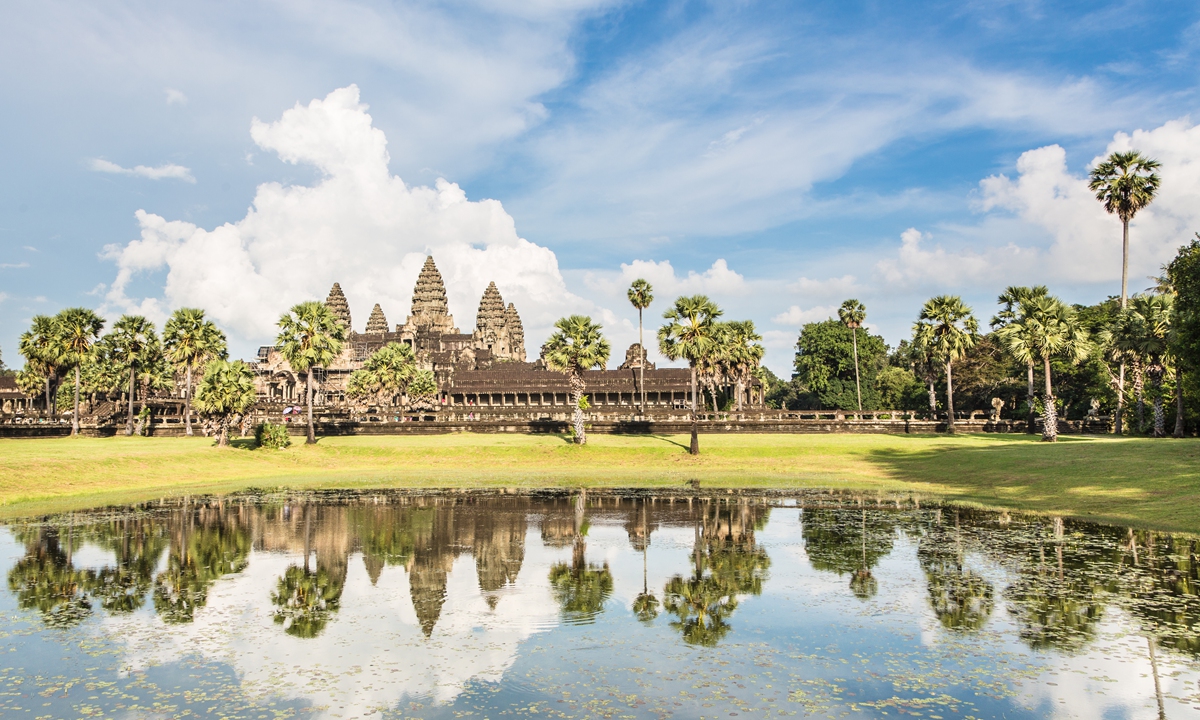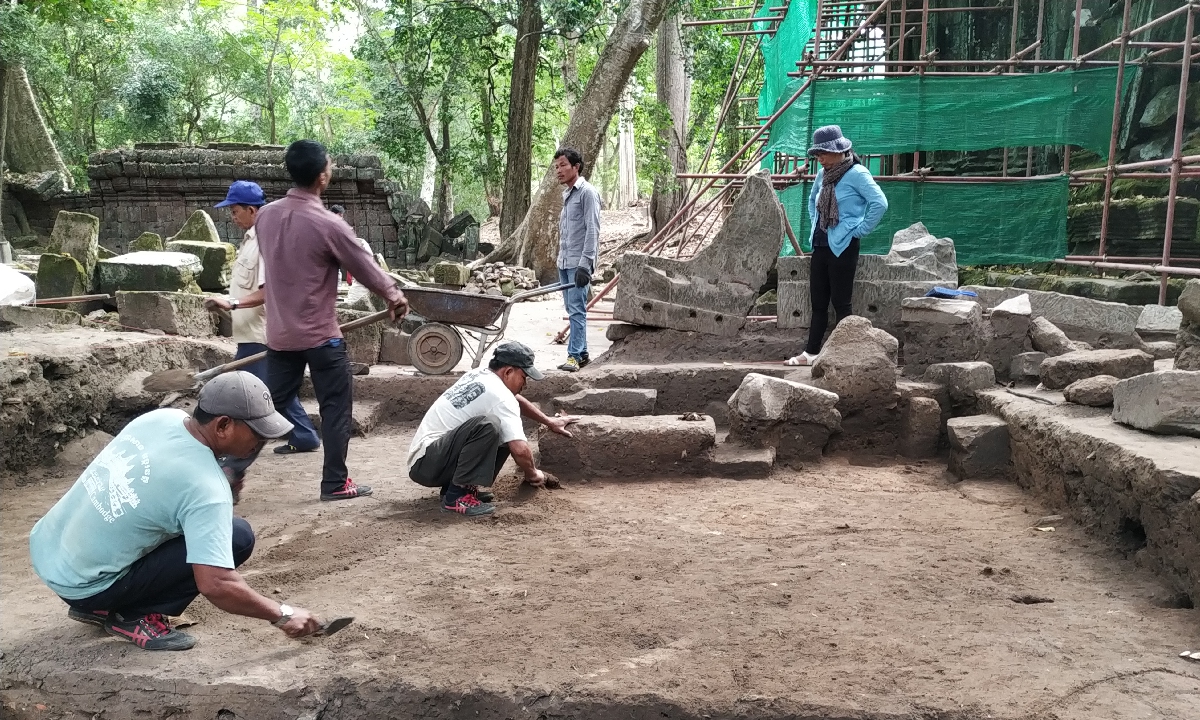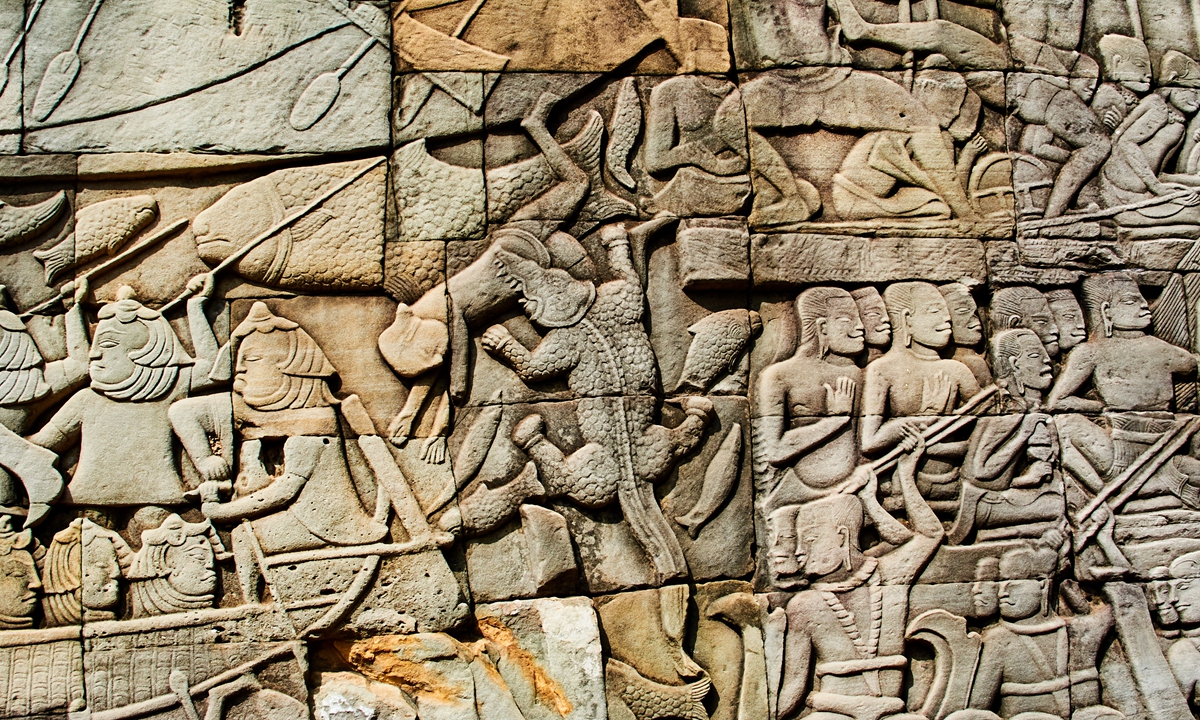
A scene in Angkor Wat Photo: VCG
Editor's Note:
Chinese archaeology has entered a golden age in the past 10 years. When researching civilizations and proposing plans and solutions, Chinese archaeologists must study the impact of foreign civilizations. Chinese archaeologists have expanded research horizons and promoted Chinese archaeology around the world. More than 30 archaeological teams from China have carried out archaeological research in more than 20 countries, which has greatly expanded the international vision and enhanced the international influence of Chinese archaeology. The China-proposed Belt and Road Initiative has made such international cooperation a common practice between China and other countries.
In this series, the Global Times will explore how China's archaeological teams have helped preserve and carry out research together with other countries, as well as promoted mutual communication and exchanges among different civilizations.
Deep in a forest in northwestern Cambodia, the minaret of an ancient stone city glistens in the sun, soaring skyward above the Angkor Archaeological Park. Such a treasured cultural heritage, laden with artistic designs such as bas-relief galleries that depict scenes of daily life of ancient Cambodians, has now been revived by the hands of Chinese conservators and archaeologists, symbolizing the enduring friendship and cultural connection between the two countries.
Undoubtedly, the park has long been the most enchanting site for global visitors who swarm upon it to see the beauty and legend of the grand Cambodia Kingdom.
Covering an area of 401 square kilometers, the Angkor Archaeological Park site contains the magnificent remains of the different capitals of the Khmer Empire from the ninth to the 15th century. It consists of scores of key temples such as the Angkor Wat, Bayon, Chau Say Tevoda and Ta Keo, among others, offering scholars and visitors a precious window into Cambodia's past.
Ancient China's Silk Road ties to Cambodia's Angkor Dynasty date back to 1296, when the Yuan Dynasty (1279-1368) diplomat Zhou Daguan visited the Khmer Empire and produced the only surviving first-person account of the civilization that built Angkor. His writings
A Record of Cambodia: The Land and Its People later guided countless explorers to discover the ancient ruins of Angkor that had remained hidden in the forest for hundreds of years.
Today, in this ancient and mysterious land, a group of Chinese archaeologists, in cooperation with their Cambodian counterparts, continue to reinvigorate the miracle of Angkor via a revitalized Silk Road.
The Angkor complex consists of 200 stone monuments. However, due to heavy rains, looting and lack of protection for centuries, most Angkor temples, built between the seventh and the 13th centuries, were seriously damaged.
In order to better protect and conserve these gems of human civilization, China became one of the first countries to join the International Action for Safeguarding Angkor, an international campaign launched by Cambodia and UNESCO in 1993.
Three decades on, the preservation efforts of the Chinese team in Cambodia record how China has gone from being a beneficiary in global cooperation in archaeology to a vital contributor and leader in recent years.
With the successful restoration of Chausay Tevada in 2008 and Ta Keo in 2018 in the Angkor Archaeological Park, the Chinese team can speak with strength having earned trust and a good reputation with their professional expertise.
In January 2018, the Cambodian government officially handed over the ruined Royal Palace, the most core part of Angkor Thom, to the Chinese team for restoration under an agreement between the two countries.
"The Cambodian government's decision shows its high recognition of what we have achieved in Cambodia. It is also a sign that China has become a reliable participant in the protection of Cambodia's cultural heritage," Li Liusan, the director-general of Chinese Academy of Cultural Heritage, told the Global Times.

People work at a restoration site in the Angkor Archaeological Park, Cambodia. Photo: Courtesy of the Chinese Academy of Cultural Heritage
A way to step over difficulties
As part of the third phase of China's efforts to protect Angkor, the Royal Palace project is expected to take 11 years to complete with financial aid from China, the Xinhua News Agency reported.
"It is a very exciting process to feel the magnificent Angkor civilization unfolding slowly in front of me," Wang Jing, an engineer from the Chinese Academy of Cultural Heritage, described her experience restoring cultural relics in Angkor.
"I feel very lucky to be part of this task," Wang said.
Wang told the Global Times that her team started comprehensive archaeological research for the palace project in 2019, and recently completed excavations around a key part of the palace.
A digital tracking system and records are also important part of the palace project, which encompasses various ruins such as pools, plants and the surrounding environment around the palace, Wang introduced.
Located in the core area of Angkor Thom, the palace ruins are highly valuable and significant for research into the country's history. However, it faces many challenges such as unsteady stone structures, a poor drainage system and fallen key sections that will be difficult to restore.
"Moreover, the burial grounds in the palace area are complicated. So before starting restoration, we called for experts from various fields such as mapping, geology, archaeology, architecture, landscape, geotechnical engineering, botany and biology to work together for cross-research with our Cambodian colleagues and finally were able to overcome a series of obstacles," Zhao Yanpeng, an assistant engineer on the team, told the Global Times.
To better understand the temple's structure and restore it with precision, the Chinese team used the most advanced technology, including 3D laser scanning and mapping, to build a complete digital model of the site.
They also archive those fallen pieces, each with an ID file including picture and dimensions. That enables engineers to measure every fallen part and gap in computer, and then search the right stone that can fit in the gap, the expert noted.
It is fair to say that China's achievement in Angkor reflects China's booming technological strength in cultural relic conservation over the past three decades, said Li.

A carved wall in Angkor Wat Photo: VCG
A way to gain trustOn December 19, 2022, Cambodia awarded honorable medals to two Chinese experts in recognition of their contributions to restoring the ruined temples. Cambodian Deputy Prime Minister Men Sam An presented medals to Yuan Mengxi and her colleague from the China Academy of Cultural Heritage.
One of the earliest global forces in protecting Angkor, the academy, under the guidance of the National Cultural Heritage Administration of China, has formally sent Chinese experts to Cambodia since 1998.
China's restoration effort of the Angkor has been widely praised for its achievements and level of quality. The Chinese team applied most advanced technology and ideas to restore the Angkor site and helped cultivate local talents join protection efforts by setting up joint labs and training as part of the Royal Palace project, Yuan, who first went to Cambodia in 2016, told the Global Times.
Long Kosal, a deputy director-general of the APSARA National Authority - the Cambodian department responsible for managing, safeguarding and preserving Angkor, said that China is one of the key contributors to safeguarding, preserving and developing the ancient site. Cambodia highly appreciates the work of Chinese experts, which he called, "very professional, effective and outstanding," according to Xinhua.
In the eyes of Chinese experts, the Angkor restoration project is a multi-dimensional "arena" that provides a platform for the exchange - and sometimes competition - of technology and culture between different countries.
"The Chinese team's conservation concept for Angkor is based on a deep understanding of Angkor civilization, as well as respect for the authenticity and integrity of the Angkor historic sites. We often study the history of Angkor by ourselves to understand the value of the palace from the perspective of Angkor civilization and the evolution of the city," said Chinese team member Huang Wenlan.
"We often find that the cultural closeness between China and Cambodia as neighbors supports our restoration works as we can better understand each other on a cultural level. Increased cultural exchanges over the past decades have also enhanced this mutual trust," Huang told the Global Times.
A way to a shared future
The conservation of Angkor marks the first time that China officially participated in a large international heritage program, and to some extent reflects the cultural cooperation happening in ASEAN countries as part of the Belt and Road Initiative.
China and ASEAN have mapped out a blueprint, the China-ASEAN Strategic Partnership Vision 2030, to further advance their strategic partnership and forge broader mutually beneficial cooperation channels so as to build a closer China-ASEAN community with a shared future.
At the second China-Cambodia Cultural Exchange Forum held in mid-February in Beijing, the debut of the mini-documentary
I Restore Cultural Heritage in Angkor, awakened people's memories about how the two sides have promoted youth exchanges in language learning, culture, art and heritage.
The documentary series, co-produced by China's leading electrical power producer the China Huaneng Group and the China Academy of Cultural Heritage, started shooting in Cambodia in August 2022.
The rejuvenated Angkor site is also expected to boost local tourism - Cambodia's second most important industry - as the ruins are definitely a trademark of the country's tourism and a vital source of income for many locals.
Prior to the pandemic, Angkor attracted up to 2.2 million international visitors in 2019, bringing in $99 million in revenue from ticket sales. The restoration project also provides a lifeline for many locals. More than 140 villagers are working on the project, Xinhua reported.
Xu Liuliu contributed to the story.






